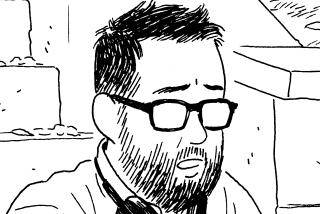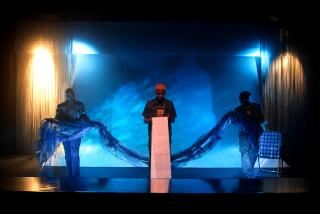Adrian Tomine plays against type in ‘Killing and Dying’

Adrian Tomine’s eighth book, “Killing and Dying” (Drawn and Quarterly: 128 pp., $22.95), is his most intentional — or perhaps, it’s more accurate to say it grew out of specific imperatives. The 41-year-old comics artist gave himself a set of guidelines to follow. “There’s a page in my sketchbook,” he says, “in which I was explicit about the parameters of this project.”
The first of these “rules” involved giving himself the freedom to approach both form and content differently than he had in the past. As an example, he cites “A Brief History of the Art Form Known as ‘Hortisculpture,’” the first of the six stories collected in the book.
Here, he plays off the newspaper comics format, developing his narrative as a series of four-frame strips, each with its own arc and punchline, stand-alone elements that add up to a larger whole.
“I talk about rules,” Tomine elaborates with a small smile, “but they’re almost little permissions. My career began in opposition to these sorts of comics. I hated ‘Dilbert.’ But being a rebel can be reactionary, so I decided to take an opposite stance and try to create something that was as cartoony as anything I had ever done.”
What Tomine is describing is the need to push himself, which is the essence of the artist’s life. Sitting in the lobby of the Biltmore Hotel in downtown Los Angeles, wearing jeans, a jacket and black-rimmed glasses, he is considered and thoughtful about both the new book and the landscape of his career.
In addition to his books, Tomine, who lives in Brooklyn, has designed book and album covers and regularly draws for the New Yorker; he has published the comics magazine Optic Nerve since he was 16.
“Really,” he says with a laugh, “it’s a teenage hobby that got out of control” — but if there’s some truth in that, more essential is the notion of progression, of engagement, of how our work changes us as we change with it, the challenges of growing in a creative form.
“If someone were to read everything I’ve done,” he suggests, “they’d get a sense of how I’ve aged. Young people” — and now he looks down as if turning his gaze inward — “have limited experience. I had a mundane, happy childhood, without much struggle. My 20s were peaceful, privileged, but still I felt the desire to write angsty dramas. I couldn’t predict how things would change.”
Some of those changes involve having children, which, Tomine notes, “goes hand in hand with giving up a sense of being cool.” He’s joking, but not really, as anyone who’s raised a family knows.
And yet, how does this feed work that avoids what Tomine calls “the landmines of sentimentality”? One answer, perhaps, can be found in his 2011 book “Scenes From an Impending Marriage,” an offhand account, originally created as a gift for guests at his wedding and published only after the fact.
Another emerges throughout “Killing and Dying,” which seeks to push into domestic territory in other ways. The title story, for instance, portrays a family: bitter father, clumsy teenage daughter, mother dying of cancer but holding on for as long as she can. The disease is never mentioned, although the images reveal a slow wasting away.
“All stories are about a bigger story,” Tomine insists, “but I want to view them through the small pinhole of one character’s perception.” Here, then, even as we think we’re seeing the tensions between a daughter and her father — she, who wants to be a stand-up comic; he, who derides her ambition out of his own fear — what is actually revealed is their reconciliation, their slow and open-ended accommodation in the shadow of the mother’s death.
For Tomine, this is not just a matter of language but of drawing as well. In his 2007 graphic novel “Shortcomings,” he sought an almost documentary level of detail, in which real-world settings (Berkeley, primarily) were re-created so specifically that they might be recognized beyond the pages of the book.
In “Killing and Dying,” his purpose is different: to have the art work in service to the story rather than the other way around. In certain pieces — “Hortisculpture” or the chilling “Go Owls,” in which a minor league baseball fan is slowly revealed to be an abusive boyfriend — this means forgoing strict realism in favor of a broader visual approach.
“Some of this,” Tomine says, “is dark stuff, and to go totally realistic would just be overkill.” At the same time, he hopes that adopting a more “neutral” style of drawing might open these stories to readers unsure of how to read them, how their eyes should move across the page.
Even “Translated, From the Japanese” — which, with its large panel landscapes and still life frames (no faces anywhere), may be the purest piece of visual narrative in the collection — represents such a principle. “Yes,” Tomine acknowledges, “it’s different from cartooning. But it is closer to storybooks, which we all know how to read.”
If this sounds a bit like playing against type, that’s part of the idea. “Killing and Dying” was conceived in reaction to “Shortcomings,” which many readers regard as autobiographical, to Tomine’s detriment. Ben Tanaka, its protagonist, is uninterested in ethnicity or racial politics, despite the activism of his girlfriend, Miko.
“The book was not intended to be political at all,” says Tomine, fourth generation Japanese American, “but that upset some people.” As a result, he has turned, explicitly, to fiction with “Killing and Dying”; none of its characters bears direct resemblance to him.
“I wanted,” he says, “to be as invisible as possible as an artist. I wanted to differentiate between myself and who I’m writing about. I was sick of one way of working. I wanted to start fresh with each one.”
Such a comment brings us back to the concept of intention, to an artist trying to function differently. It’s a fascinating process to watch unfold in public, in the pages of a book.
“The best thing for me about ‘Killing and Dying,’” Tomine enthuses, “is the stuff I didn’t know I could pull off.” He’s talking not only about the gags and punchlines, the cartoony stuff, but also the explication of a set of characters that exists, in his words, “out of my comfort zone.” At the same time, he has already begun to ponder the challenges he now wants to address.
“I’ve never had the guts,” he reflects, “to do something like, say, Chester Brown does, and really reveal myself. So perhaps that is a challenge to consider. I’m uncomfortable revealing too much, but part of me thinks this could be fertile soil. Comfort is not always the best path.”
More to Read
Sign up for our Book Club newsletter
Get the latest news, events and more from the Los Angeles Times Book Club, and help us get L.A. reading and talking.
You may occasionally receive promotional content from the Los Angeles Times.










